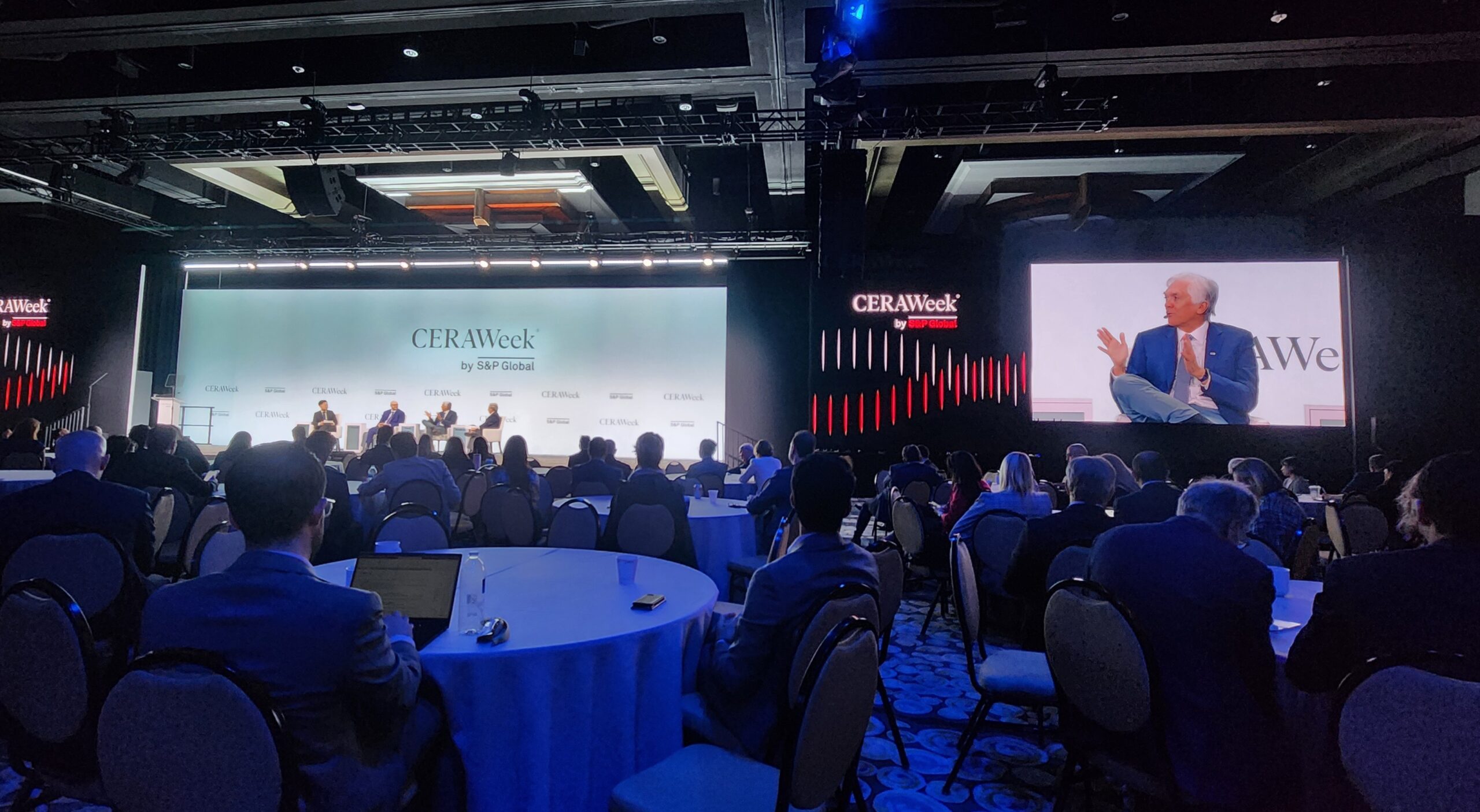Power needs, natural gas and AI dominate CERAWeek debate
Latest News
HOUSTON — The energy transition is going to happen at different speeds across the globe and be made more challenging by the rising demand for electricity coming from power-hungry data centers and increasing electrification.
At the same time, cheap and readily available natural gas will continue to be a critical bridge fuel for the foreseeable future until lower carbon technologies are scaled up and prices come down.
These were among the top takeaways from a massive energy conference, known as CERAWeek, that dominated Houston — and news headlines — last week. Hosted by S&P Global, the event is so large its evolution to embrace cleaner energy while still being largely dominated by fossil-fuel producers is considered a reflection of the world itself (read more about the confab here).
Tension between energy security, exacerbated by Russia’s invasion of Ukraine, and clean energy, whose commercialization aims to stave off the worsening impacts of climate change, drove debate among the thousands gathered at the conference, considered the largest of its kind in the world.
Here are your highlights from Houston:
- AI was everywhere at the conference, both the opportunities and potential costs. Andrés Gluski, the CEO of the global renewable developer The AES Corporation, joked that he was thinking of changing the company name from A-E-S to A-I-S because of the “tremendous demand” AES is seeing for electricity to power the energy-hungry data centers that drive AI, or artificial intelligence. Gluski also highlighted the efficiencies AI can bring to AES’ operations. “I am excited about AI because I think it will make us much more efficient, not only in operations, but also in development — seeing where is the best place to place these data centers and renewables,” Gluski said. Check out our Cipher News story published Wednesday for more. — Cat Clifford

Andrés Gluski, the CEO of the global renewable developer The AES Corporation, speaks on the plenary stage of the main CERAWeek conference area on March 21. Photo credit: Cat Clifford.
- Demand for electricity in the U.S. is rising for the first time in decades, giving hydrocarbon companies runway — while the legitimacy of that runway depends on who you talk to. Major tech companies are racing against each other to build the best AI as fast as possible and that’s made them all voracious for clean energy to power energy-hungry data centers. Also, recent laws passed in the U.S. are driving chip manufacturing in the U.S. and “anti-China rhetoric” is driving renewed interest in domestic manufacturing, said Kleber Costa, chief commercial officer for AES. All of this is creating “a renaissance in manufacturing,” Costa said, which is adding to rising demand for electricity. Electrification and in particular the adoption of electric vehicles is also pushing up total demand for electricity. Taken together, the growing demand for electricity is eclipsing some of the climate benefits of the recent impressive growth in renewables and giving oil and gas companies defense for the continued use of hydrocarbons. — Cat Clifford
- Flush with profits, oil major executives set the tone that oil and gas will continue to play a dominant role in the global energy mix despite the $9.5 trillion that Saudi Aramco head Amin Nasser said has been spent on global energy transition during the past two decades. “We should abandon the fantasy of phasing out oil and gas” and instead focus on helping poorer countries grow their economies, said Amin Nasser, head of the world’s largest oil producing company, Saudi Aramco. This sentiment was echoed in milder terms in successive panels by other oil and gas executives as well as government officials from Indonesia, Japan and India who all agreed natural gas will play the role of a “bridge fuel” during the transition to maintain energy affordability and security. India has plans to double the share of natural gas in its energy mix in the next five to six years and has already opened up three times more shoreline to gas exploration, previously considered off limits, Pallavi Jain Govil, hydrocarbons director general for the Indian Ministry of Petroleum and Natural Gas, told CERAWeek attendees. — Amena H. Saiyid
- Scaling up from innovation to commercialization while also bringing costs down was a topic of urgent focus for the more nascent clean energy technologies, ranging from carbon capture technologies to clean hydrogen to small nuclear reactors. In one session in a conference space called Agora focused on innovation, Raffi Garabedian, co-founder and CEO of Electric Hydrogen talked about accelerating the transition to low carbon hydrogen. “The big boys over in the other place — over there,” Garabedian said, referring to the oil and gas majors mostly speaking in an adjacent building of the conference, “they’re looking down their noses saying this can’t be done, it’s going to take forever, let’s get realistic, let’s keep on doing what we’ve always been doing for the past 100 years. I heard that 12 years ago in the solar industry. They’re wrong, but we have to get started,” said Garabedian, whose company makes machines called electrolyzers to produce hydrogen from clean electricity. — Cat Clifford

Raffi Garabedian, co-founder and CEO of Electric Hydrogen talked about accelerating the transition to low-carbon hydrogen in a session Tuesday in the Agora space of the conference, which focuses on innovation. Photo credit: Cat Clifford.
- The lack of financing for emerging economies was a top concern expressed by government officials from these types of countries, including several from Latin America and the Caribbean. More than half (52%) of the $1.6 trillion in spending on clean energy in 2022 was by advanced economies including the United States and the European Union, 32% was by China and just 16% from emerging economies and developing economies, according to the International Energy Agency. “The little money that is available to us is hard to access,” Trinidad & Tobago’s Minister for Energy and Energy Industries Stuart Young told Cipher on the sidelines of the conference. Latin American countries along with Caribbean nations have contributed 5% of greenhouse gas emissions since 1971, according to the IEA. Asking countries that lack resources to invest in clean energy while developed countries switch to fossil fuels at the first sign of crisis is “hypocrisy,” Young said. — Amena H. Saiyid
- Increasing renewable energy penetration won’t be possible without serious investments made in transmission lines to support the added power load, said Gluski of AES. Coupled with investment in transmission is the need to have regulations that are flexible enough to accommodate changes in technology and new approaches, said Mohamed Jameel al Ramahi, CEO of Masdar, a renewable energy company run by the United Arab Emirates-government. — Amena H. Saiyid
- Identifying and locking in supply chains for critical minerals is now a priority for companies engaged in making clean technologies. Ford Motor Company’s Chris Smith said supply chains were something that was taken for granted before the pandemic, but now “we are actively identifying and seeking supplying chains for the minerals we need.” Metals like copper that are vital to clean technology are expected to face an annual deficit of 404,000 metric tons in 2028, according to S&P Global Market Intelligence. — Amena H. Saiyid
Read more in Cipher’s Top Reads and Hot Takes from other media outlets:
Biden LNG pause sours energy conferences at CERAWeek — Forbes
Amena’s take: U.S. Senator Joe Manchin, a Democrat from West Virginia, called for a pause on the Biden administration’s pause of liquefied natural gas exports, while Senator Dan Sullivan, a Republican from Alaska, said the pause is driving potential LNG buyers towards Russia.
Fossil fuel protesters rally outside CERAWeek energy conference — Houston Chronicle
Amy’s take: It’s unfortunate the people who had raised money to attend weren’t allowed to. Amena also snapped the photo below of another protest that occurred on March 19 of a “funeral” march for people whose deaths were linked to fossil-fuel pollution.

Protestors gathered on March 19 in a “funeral march” for people whose deaths were linked to fossil-fuel pollution. Photo credit: Amena H. Saiyid.
Gas industry leans on emissions tech as climate crackdown looms — E&E News (subscription)
Cat’s take: Key quote: “How do we make the gas industry as decarbonized as possible? And that really comes down to stopping flaring and minimizing methane leaks,” a governmental official told E&E News.
Climate change indicators reached record levels in 2023 — World Meteorological Organization
Cat’s take: At CERAWeek energy leaders tussled over the energy transition, with the head of Saudi Aramco calling the phase out of oil and gas a “fantasy.” This backdrop makes the WMO report more ominous.
Joe Manchin: Our energy policy is a success. President Biden should be proud. — The Washington Post
Cat’s take: Manchin says the U.S.’s “all of the above” energy policy is needed to both maintain energy security and innovate for the future. That sentiment was palpable in Houston.
U.S. Energy Department unveils roadmap for the next generation of geothermal power — Energy Department
Cat’s take: I was not surprised to see the U.S. Energy Department drop a spotlight on geothermal during CERAWeek because more than any other clean energy source, geothermal has the potential to draw on oil and gas experience.
“There is this fatigue:” Top official wants next UN climate summit to be lean — Axios
Amy’s take: A key quote: “Every country is an oil country, either on the supply side or the demand side,” said Elnur Soltanov, Azerbaijan’s deputy energy minister, at CERAWeek. I had never thought of it that way, but he has a point.
Exxon CEO says hydrogen project at risk without IRA tax credits — Bloomberg
Amy’s take: On the conference stage, Exxon CEO Darren Woods underscored the stakes of the debate over these subsidies — at least from the fossil-fuel industry’s perspective.
Editor’s note: Electric Hydrogen’s investors include Breakthrough Energy Ventures, which is part of Breakthrough Energy that also supports Cipher.

Cipher’s Amena H. Saiyid and Cat Clifford in Houston for CERAWeek last week. Photo credit: Cat Clifford.